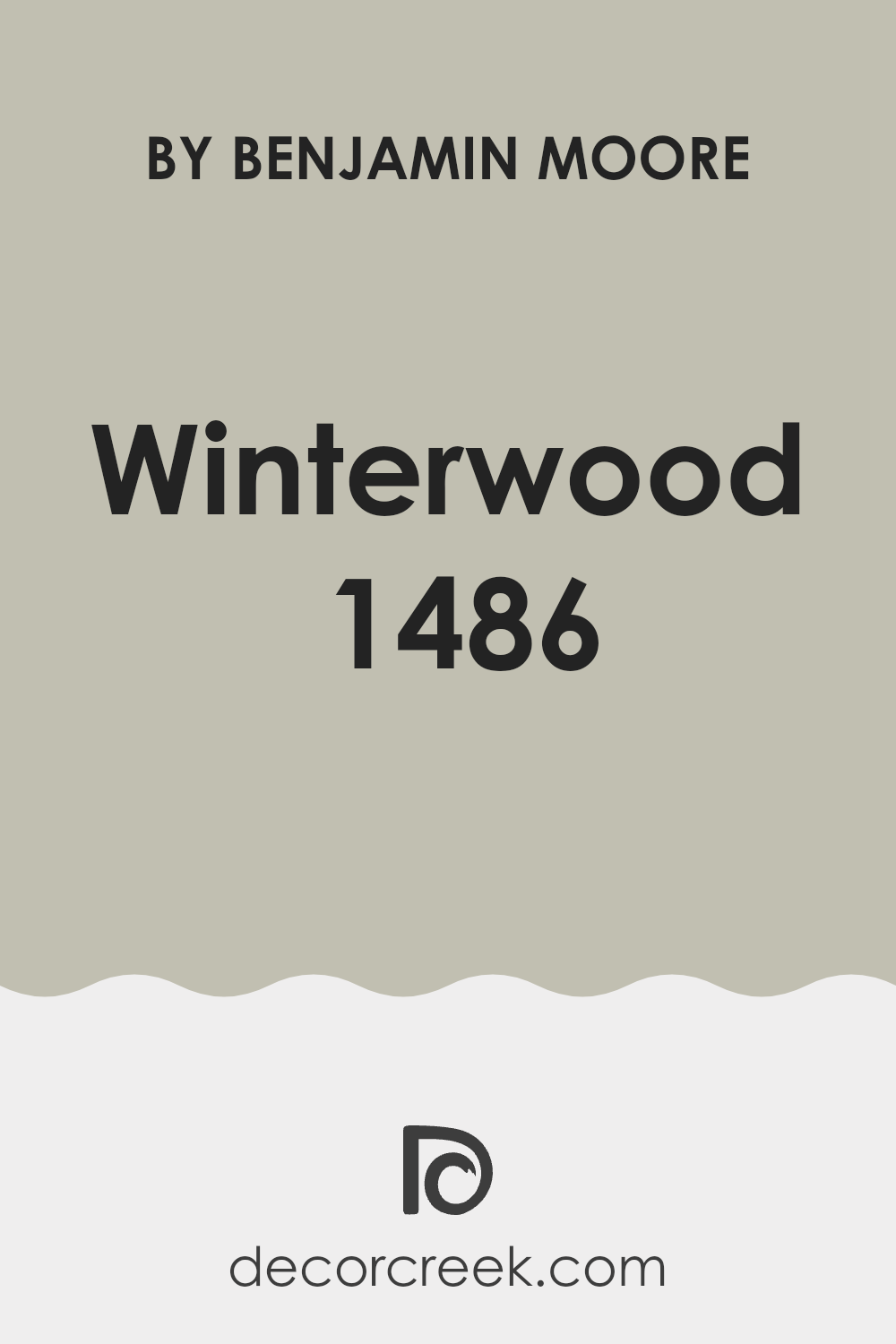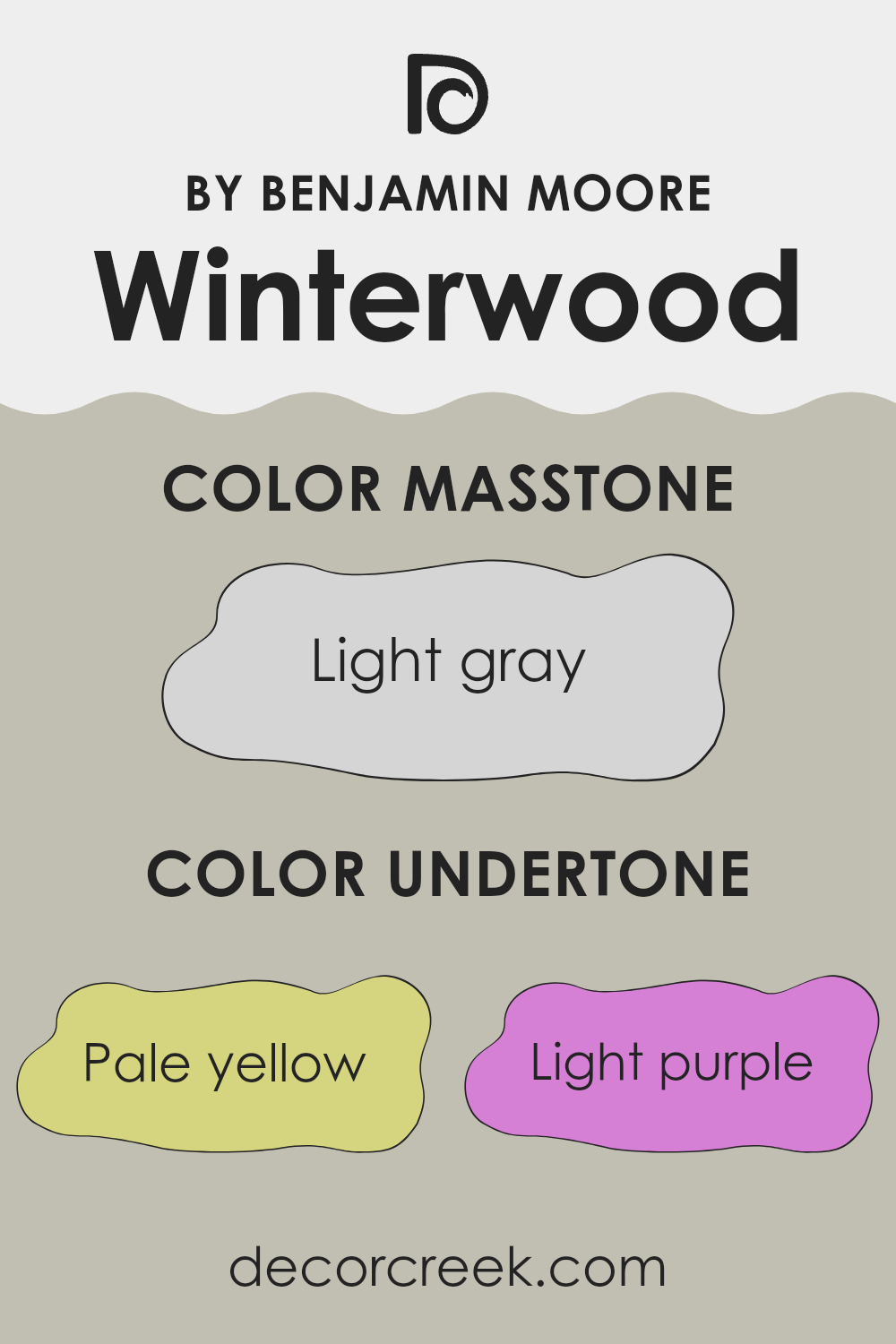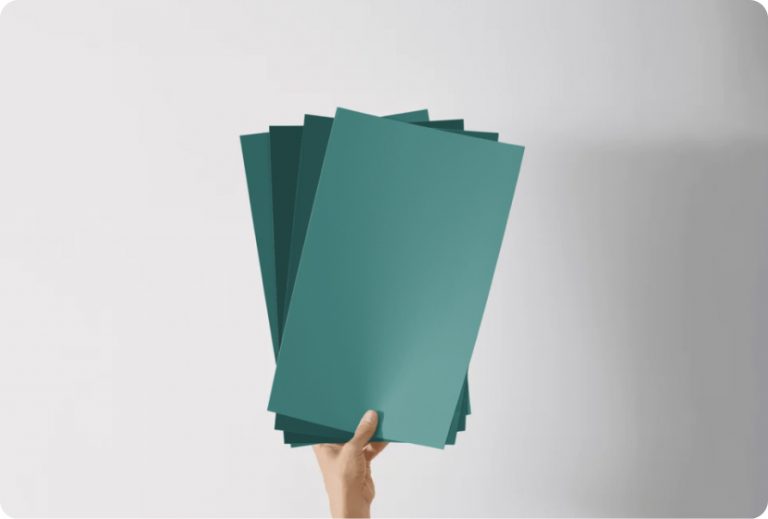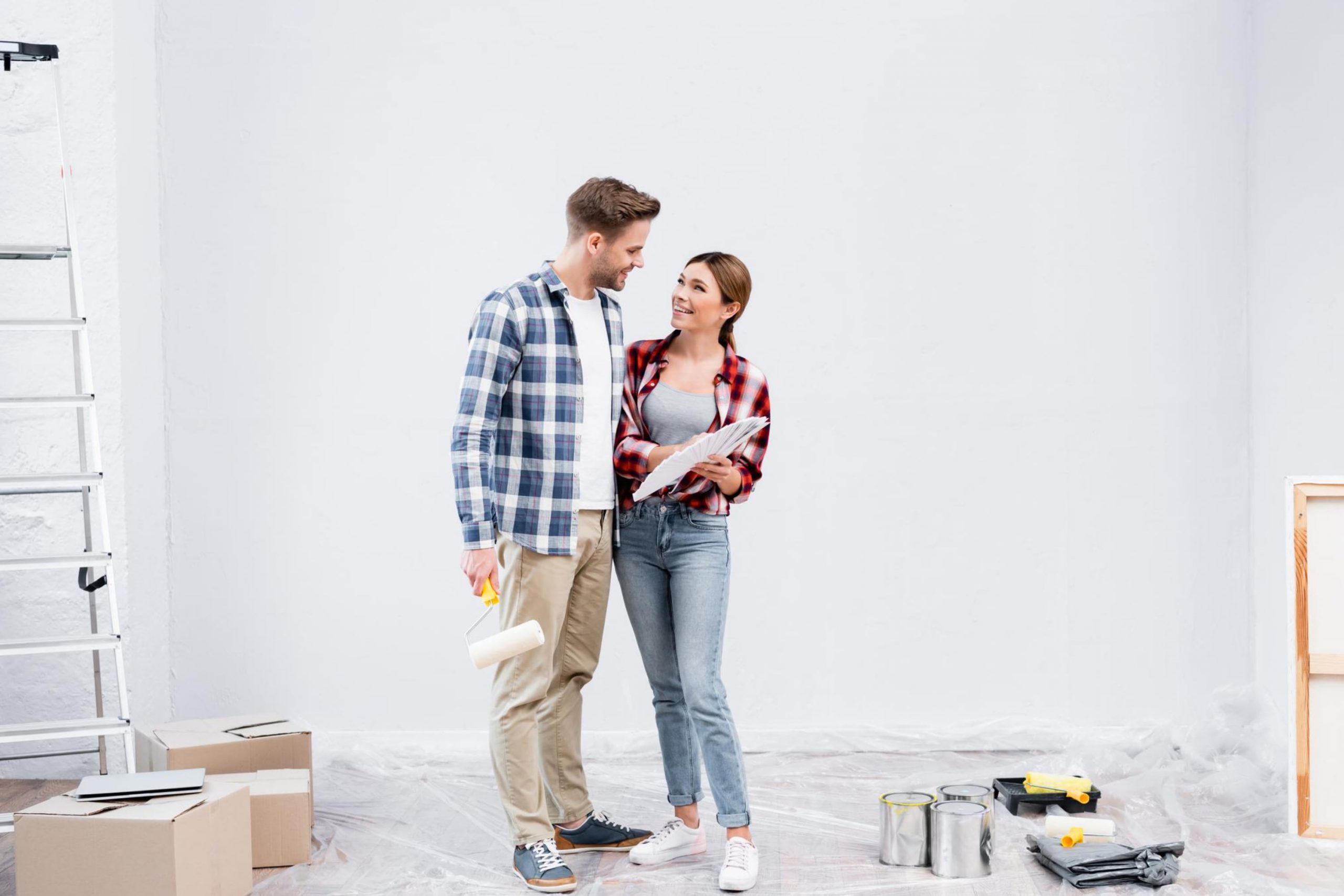If you’re considering a fresh new look for your room, let me tell you about Benjamin Moore’s 1486 Winterwood. As I searched for a paint color that offered a sense of calm without being too bold, I came across Winterwood. This color is a gentle gray-green that strikes a delicate balance between warmth and neutrality.
Walking into a room painted with Winterwood feels like stepping into a quiet, peaceful forest early in the morning. The color has an understated elegance that works beautifully in different settings, whether it’s a bedroom that needs softness or a living room that calls for a dash of nature-inspired calmness.
Let me assure you, choosing Winterwood was one of my better decisions for refreshing my home’s décor without being too intense.
As you plan your next painting project, you might see that Winterwood provides the perfect backdrop, bridging traditional tastes with modern aesthetics seamlessly.
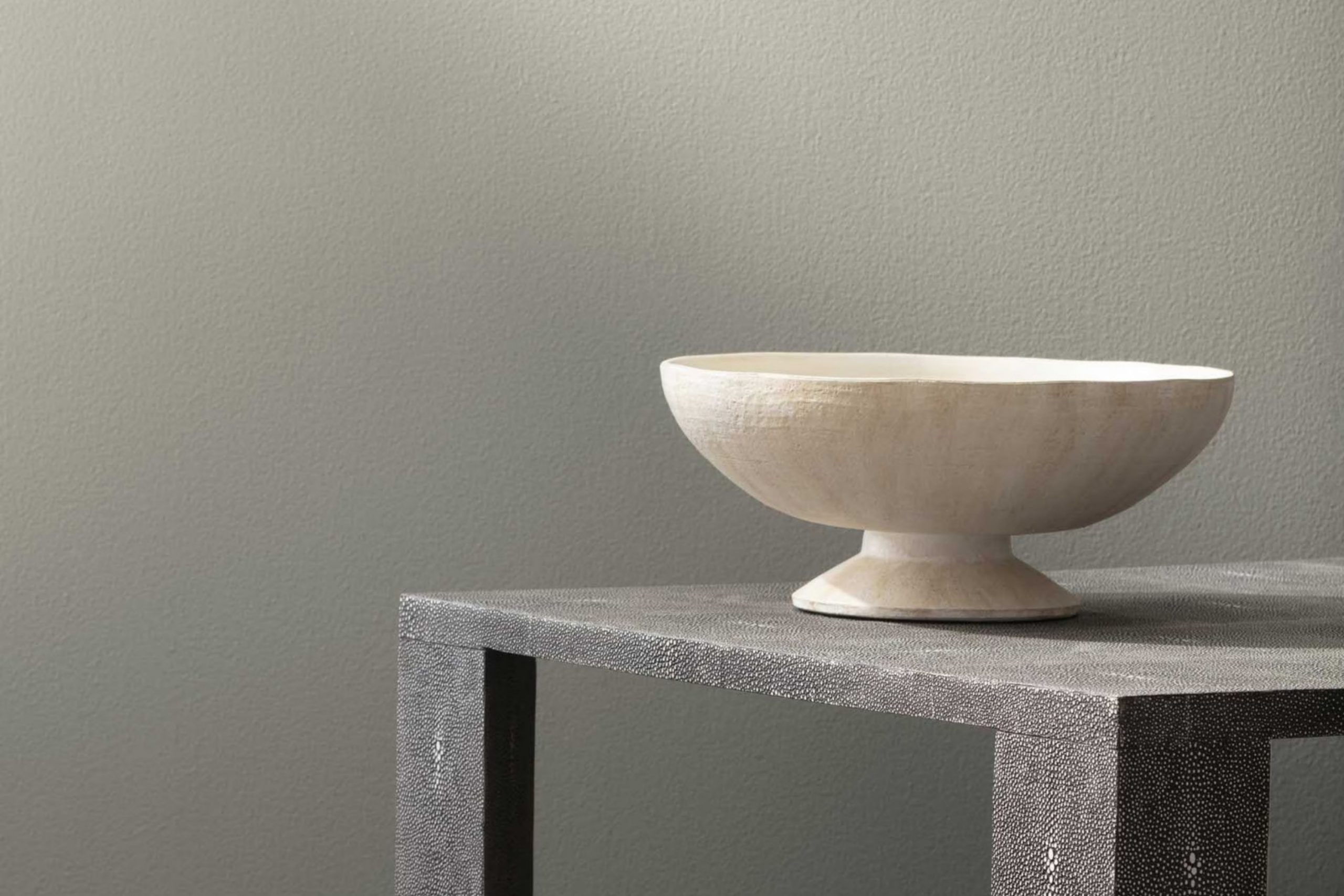
What Color Is Winterwood 1486 by Benjamin Moore?
Winterwood 1486 by Benjamin Moore is a flexible and understated color that offers a fresh, modern take on neutral hues. This shade features a soft, warm gray tone with slight green undertones, making it a unique choice for those wanting to add a subtle touch of nature-inspired calm to their living rooms. Its muted quality allows it to work harmoniously in different settings without overshadowing other design elements.
Winterwood is especially effective in interior styles such as Scandinavian, minimalist, and contemporary, as it complements clean lines and simple forms. It serves as a neutral backdrop that allows furniture and art to stand out. This shade works splendidly in rooms with abundant natural light, where it can reveal its full range of subtle undertones.
When it comes to pairing, Winterwood is highly adaptable. It coordinates beautifully with natural materials like wood, enhancing the warm tones of oak and walnut. In rooms with stone elements, such as marble or granite, Winterwood creates a soft contrast that highlights the natural textures. It also pairs well with metals, especially brushed nickel or soft matte brass, bringing a gentle yet refined look to fixtures and furnishings.
All in all, Winterwood is a classic choice for creating calm, stylish interiors.
decorcreek.com
Is Winterwood 1486 by Benjamin Moore Warm or Cool color?
Winterwood 1486 by Benjamin Moore is a soft gray color that brings a fresh and clean look to any room it’s used in. This neutral shade is highly flexible, so it works well in many different areas of a home. One of the best things about Winterwood is its ability to blend with other colors.
Whether you pair it with bright tones for a playful look or with other neutrals for a more subdued atmosphere, it adjusts smoothly. This color is especially useful in small rooms or rooms with limited natural light.
It can help make a small room appear bigger and more open because it reflects light well. Additionally, since it is a calm and gentle shade, it creates a relaxed and inviting environment, ideal for living rooms or bedrooms where comfort is a priority. Overall, Winterwood 1486 is a go-to choice for anyone wanting to add a touch of light and airiness to their home without being too intense with strong colors.
Undertones of Winterwood 1486 by Benjamin Moore
Winterwood by Benjamin Moore is a unique color that carries a variety of subtle undertones. These undertones, including pale yellow, light purple, light blue, pale pink, mint, lilac, and grey, strongly affect how the shade appears in different lighting conditions and surroundings.
Firstly, undertones can shift the way colors look on your walls. Depending on the light—whether it’s natural daylight or artificial light—these undertones can make the main color appear different. For example, in a brightly sunlit room, the pale yellow and light blue undertones in Winterwood might make the walls look a bit cooler and more refreshing. In contrast, at night under warm artificial lighting, the pale pink and lilac undertones could give a softer, more gentle feel to the room.
Using Winterwood on interior walls highlights its flexible nature since these undertones provide a subtle complexity that interacts beautifully with both furniture and décor. The mint and grey undertones bring a touch of earthiness and neutrality, offering a solid base that complements various types of furniture, from wood to metal and even brightly colored fabrics.
These layered undertones make Winterwood an excellent choice for rooms needing a balance of warm and cool tones, fitting easily with multiple decorating styles—whether it’s a modern minimalist look, a cozy country style, or something in between. This flexibility is ideal for creating a fresh, welcoming environment in your home where the walls themselves play an active role in the overall aesthetic.
decorcreek.com
What is the Masstone of the Winterwood 1486 by Benjamin Moore?
Winterwood 1486 by Benjamin Moore has a masstone of light gray, identified by the color code #D5D5D5. This particular shade of gray is gentle and subtle, making it a great choice for home interiors where a calm and simple yet stylish look is desired.
The light gray color works well in many settings, acting almost like a neutral backdrop. It pairs easily with both bold and soft color palettes, allowing for flexible options in decorating. This makes it ideal for common rooms like living rooms and kitchens where you might change decor over time.
Additionally, the lightness of the color helps to brighten rooms, making them feel more open and airy, which is especially helpful in smaller or darker areas. Overall, Winterwood 1486 offers a fresh and clean look, enhancing the aesthetic of a home without being too intense with color.
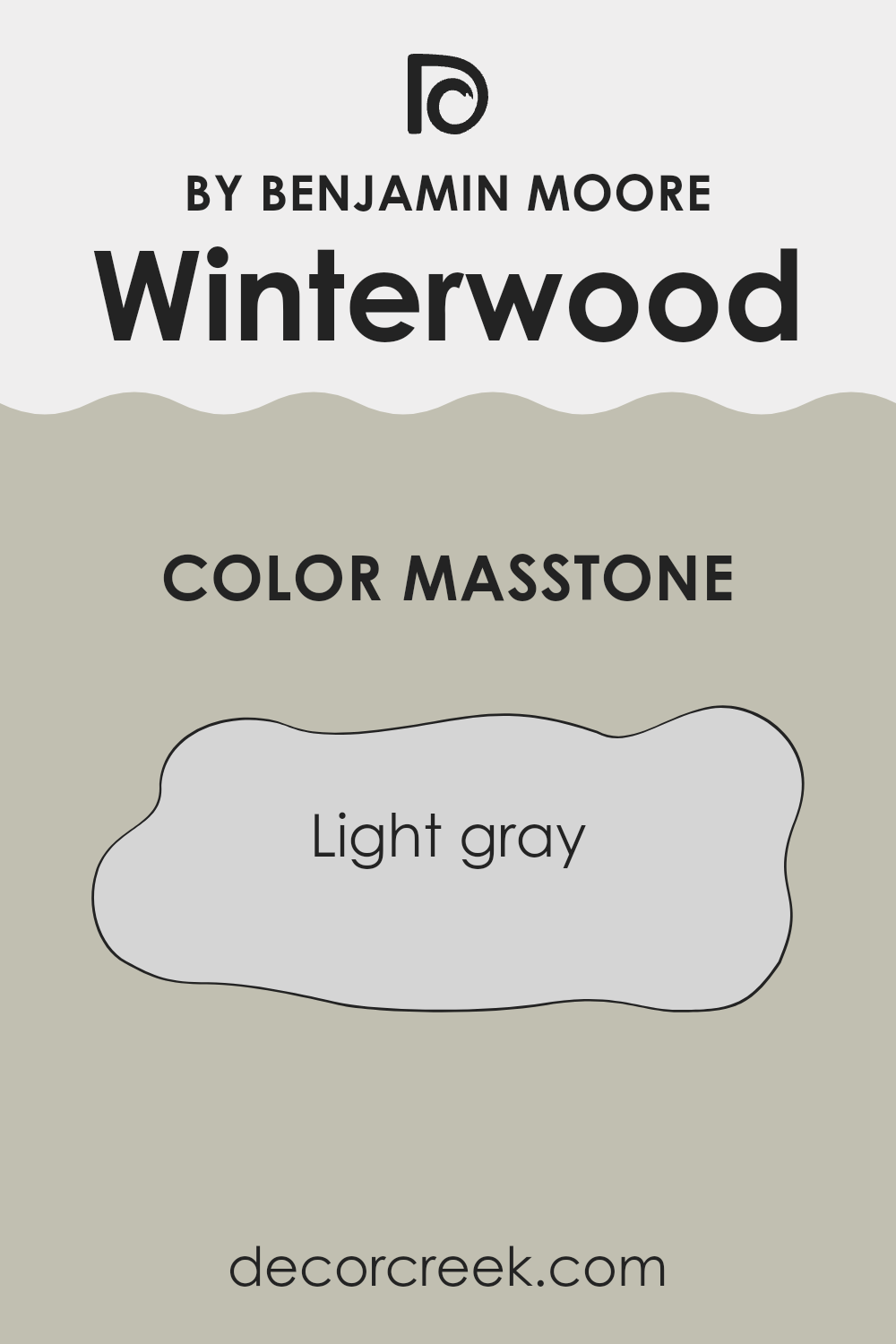
How Does Lighting Affect Winterwood 1486 by Benjamin Moore?
Lighting plays a crucial role in how colors appear in any given room, significantly impacting our perception of a hue. Different lighting conditions can change the way we see color, making it seem brighter, darker, or altering the actual shade. Natural light, artificial light, and the orientation of a room with respect to sunlight can all affect the appearance of colors like Winterwood 1486 by Benjamin Moore.
Artificial Light:
In artificial lighting, Winterwood 1486 varies depending on the type of light used. Under warm artificial light, such as incandescent bulbs, this color will appear softer and slightly more muted, with its grayish-green tones becoming more pronounced, giving a cozy and comfortable feel. Cooler artificial lights, like LEDs, might bring out more of the green and gray undertones, making the color look more vibrant and fresh.
Natural Light:
Natural light shows the truest form of Winterwood 1486. In daylight, this color can look different as the sunlight shifts. During the midday, when sunlight is brightest, the color will look lighter and more neutral, revealing a delicate balance of its green and gray components.
Room Orientation:
- North-Facing Rooms: North-facing rooms could make Winterwood 1486 appear a bit shadowed due to the cooler, softer light typically found here. The color may seem a bit more grey than green, creating a calm and quiet setting.
- South-Facing Rooms: In south-facing rooms, where light is abundant and warmer for most of the day, Winterwood 1486 will appear lighter and slightly warmer. The warm light can enhance the greenish tint, making the room feel lively and airy.
- East-Facing Rooms: East-facing rooms receive a strong, warm light in the morning that transitions to cooler light as the day progresses. In the morning, Winterwood 1486 will look vibrant and fresh. As the day moves on, it’ll take on a more subdued, cooler tone.
- West-Facing Rooms: In west-facing rooms, this color will experience the reverse of east-facing ones. It starts with muted, cooler tones in the morning, and brightens up with warmer, vivid hues in the afternoon and evening.
Understanding these variations can help in deciding the best use of color in different rooms based on their exposure to light and the room’s purpose. Colors like Winterwood 1486 by Benjamin Moore can therefore be adjusted to enrich the mood and atmosphere of a room according to its lighting conditions.
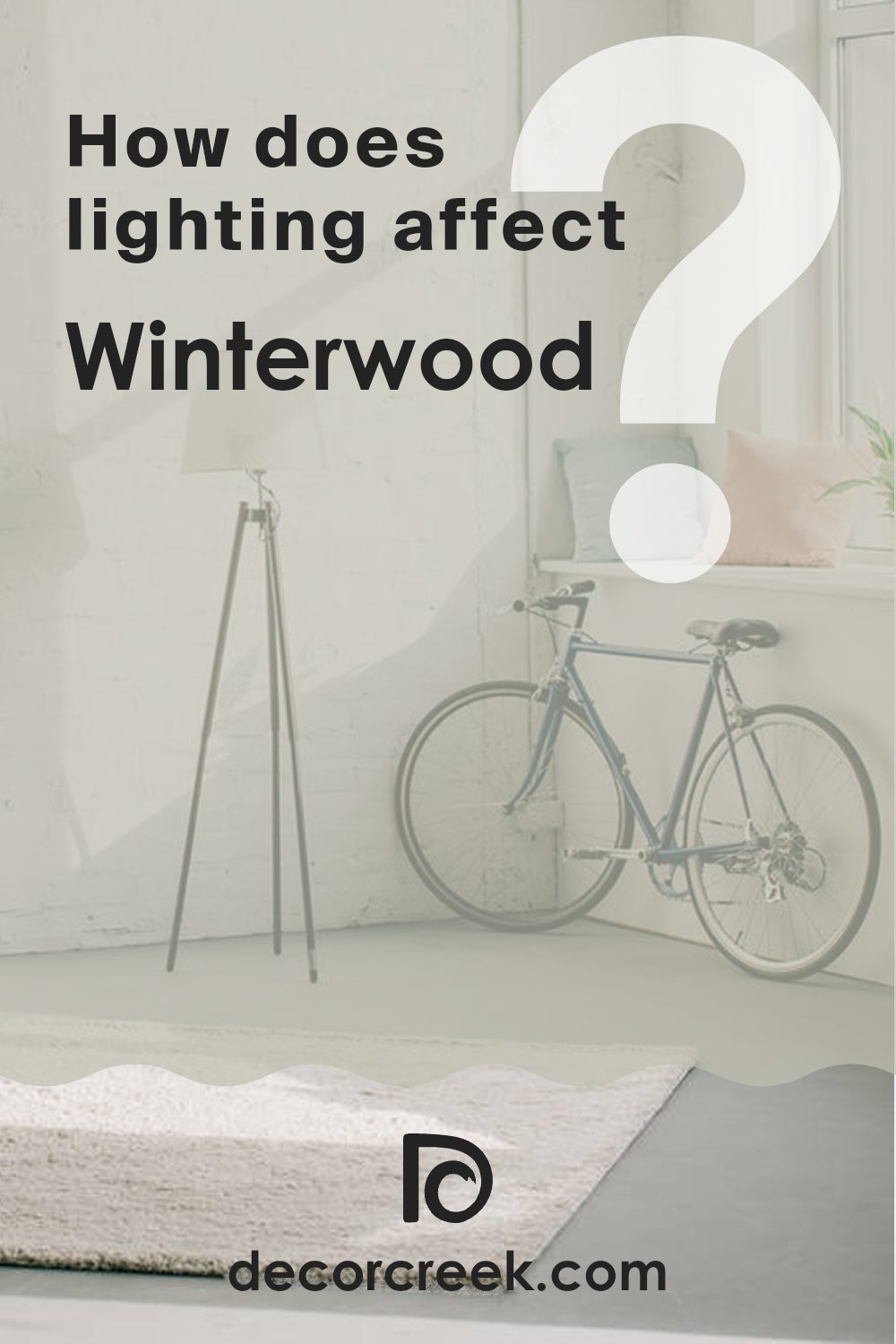
What is the LRV of Winterwood 1486 by Benjamin Moore?
LRV stands for Light Reflectance Value, which is a measure of how much light a color reflects back into a room. It ranges from 1, which represents the darkest colors that absorb most of the light, all the way to 99, which are the brightest and reflect most of the light.
This value helps you determine how a color will look once it is applied to your walls. It influences the atmosphere of a room because lighter colors can make a room feel more open and airy while darker colors can make it feel more cozy and condensed.
With an LRV of 50.95, the color Winterwood by Benjamin Moore is almost in the middle of the scale. This means it neither reflects light excessively nor absorbs it heavily. In practical terms, it’s a flexible color that balances between adding warmth and maintaining some brightness to the room.
It can work well in rooms that receive either a lot of daylight or limited natural light. In rooms with more light, this color will appear lighter and more vibrant, while in dimmer areas, it will bring a subtler, warmer tone.
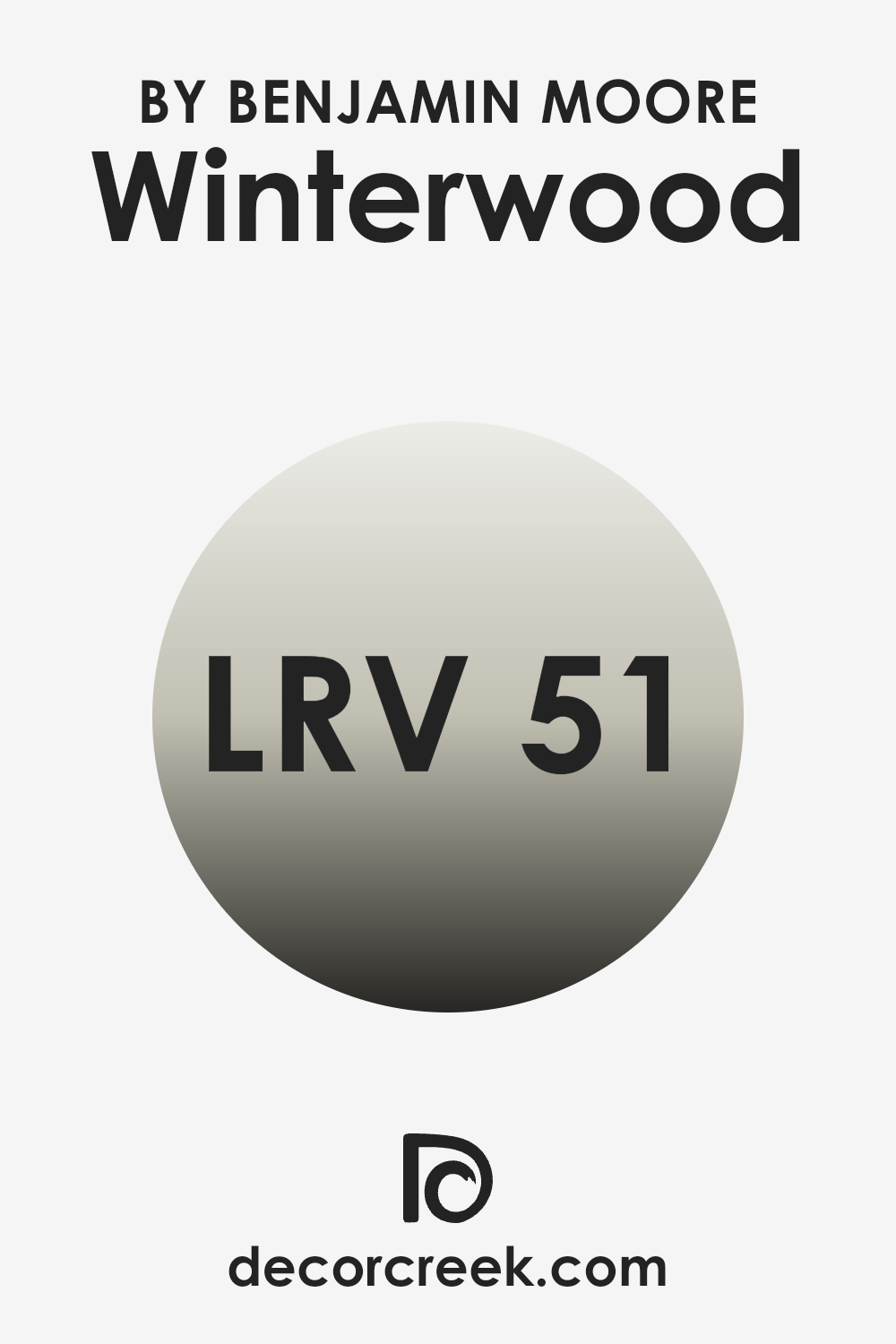
Coordinating Colors of Winterwood 1486 by Benjamin Moore
Coordinating colors are selected shades that complement a primary color to create a harmonious palette. These colors often bring balance, enhance the main hue, and help to establish a visually appealing and consistent theme throughout a room.
Using coordinating colors effectively can add variety while maintaining a cohesive look, ideal for aesthetic and functional interior designs. It’s essential to choose coordinating colors that share some similar undertones or are on opposite sides of the color wheel to the primary color to make sure they highlight rather than clash.
In the case of Winterwood by Benjamin Moore, a gentle, muted green-gray, four coordinating colors that pair excellently with it are Muskoka Trail, Monterey White, Saddle Tan, and Townsend Harbour Brown. Muskoka Trail is a warm, earthy taupe that blends with Winterwood’s subdued tones, lending a sense of grounded stability to any room it adorns.
Monterey White offers a clean, crisp contrast. It’s a fresh cream shade that softens and brightens rooms, providing a subtle lift to the cooler main color. Saddle Tan is a robust, medium brown that adds depth and warmth, well-suited for creating inviting, cozy rooms or as an accent trim to frame the more neutral Winterwood.
Townsend Harbour Brown stands out as a deep, rich brown, perfect for emphasizing an elegant, grounded feel or highlighting key architectural features with a strong presence. Together, these colors support Winterwood in many design settings, ensuring a warm, welcoming environment.
You can see recommended paint colors below:
- 974 Muskoka Trail
- HC-27 Monterey White
- 1124 Saddle Tan
- HC-64 Townsend Harbour Brown
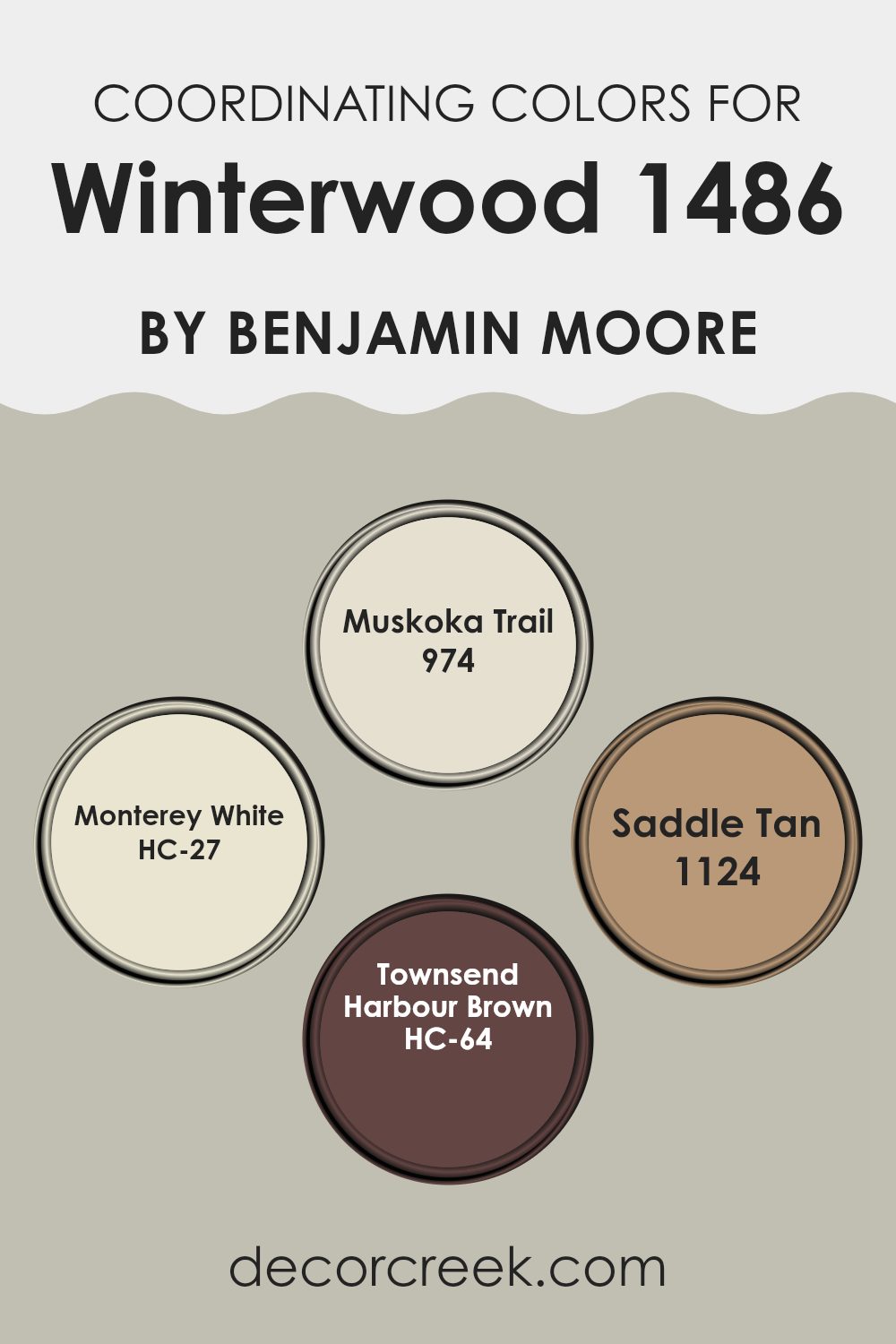
What are the Trim colors of Winterwood 1486 by Benjamin Moore?
Trim colors are essential design elements in interior decorating that define the lines and edges of a room, providing a visual framework that enhances the overall appearance. These colors are applied to areas such as door frames, baseboards, window trims, and moldings, serving not only a protective function by covering joints and gaps but also adding a distinctive accent to the room’s color palette. When paired correctly with wall colors, trim colors can create a coherent and pleasing aesthetic.
For the color Winterwood by Benjamin Moore, choosing the right trim colors can greatly affect the mood and style of the room. AF-20, known as Mascarpone, is a creamy, warm white that offers a gentle contrast, brightening the edges without being too intense against the soft, neutral tone of Winterwood.
On the other hand, OC-128, named Minced Onion, is a subtle, pale grey that provides a slightly sharper contrast, giving a clean and defined look to the trim, enhancing the depth and dimension of the room. Both colors are flexible and can blend seamlessly with the gentle hue of Winterwood, ensuring a polished and cohesive look.
You can see recommended paint colors below:
- AF-20 Mascarpone
- OC-128 Minced Onion
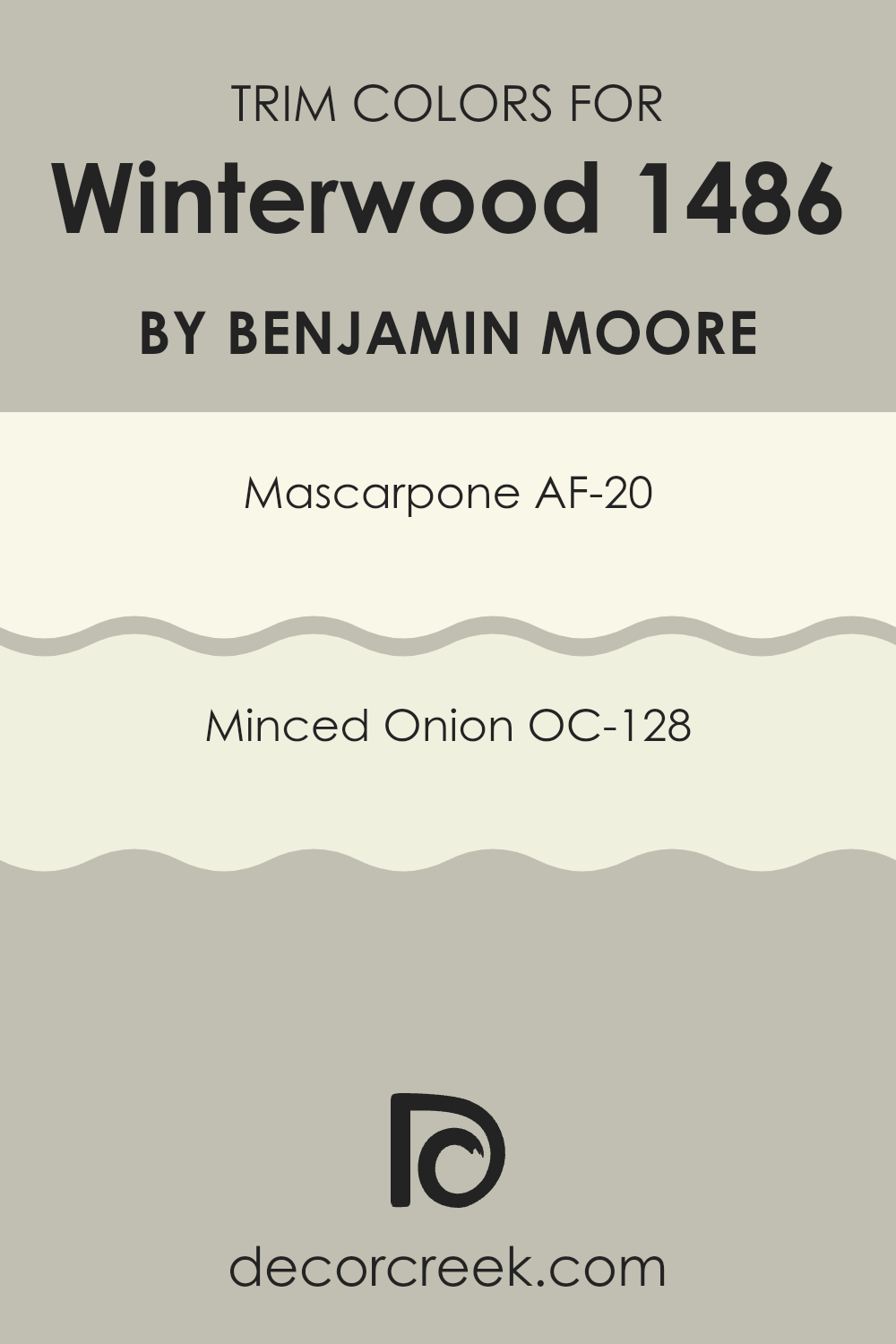
Colors Similar to Winterwood 1486 by Benjamin Moore
Similar colors are important in interior design because they help to create a cohesive and harmonious atmosphere within a room. By using shades that are close on the color spectrum, such as 1535 – Seattle Mist, and other complementary tones, designers can give a room a unified look that is pleasing to the eye.
Colors like 1485 – Brushed Aluminum, which is a light gray with a hint of blue, blend easily with others because they share similar undertones. This subtle harmony encourages a relaxed and comfortable environment since the colors support each other rather than competing for attention.
For instance, 2141-50 – Horizon Gray is another great example of a similar shade that works well with the rest. It offers a slightly warmer tone, lending a soft backdrop ideal for decorating with natural materials or richer accents. Then there’s 1501 – Paris Rain, a gray with a touch more green, which perfectly complements wood tones and metallic finishes.
Together, these shades form a palette that is easy on the eyes and highly adaptable, making it simple to integrate with different décor styles and personal tastes. The choice of these matching colors can effortlessly create a sense of continuity throughout a home, which is why they are so valued in creating lovely and peaceful rooms.
You can see recommended paint colors below:
- 1535 Seattle Mist
- 1485 Brushed Aluminum
- 2141-50 Horizon Gray
- 1501 Paris Rain
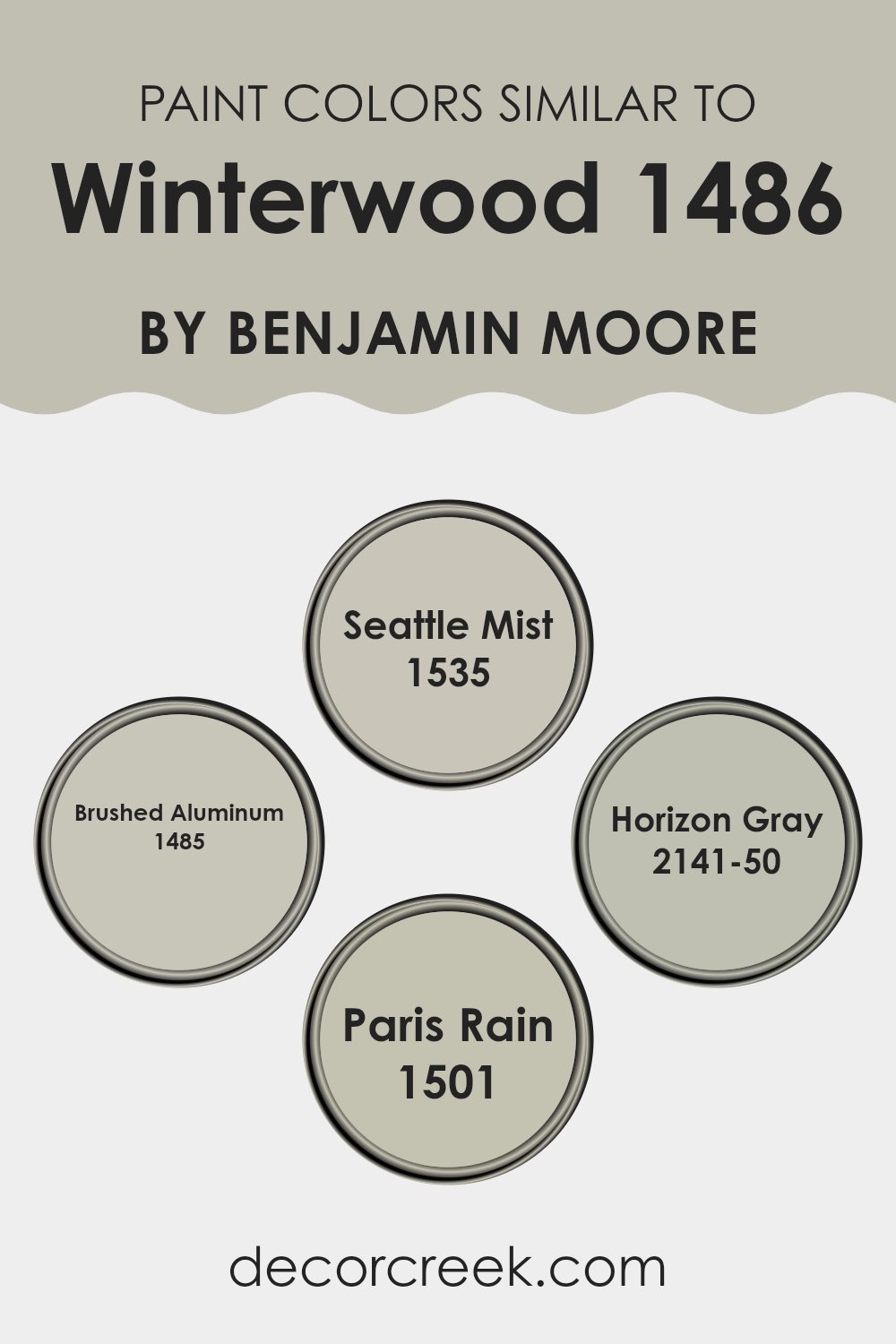
Colors that Go With Winterwood 1486 by Benjamin Moore
Choosing complementary colors for Winterwood 1486 by Benjamin Moore is crucial as it helps create a harmonious and appealing aesthetic in your home. When you select shades that coordinate well, like Devonshire Green, Brushed Aluminum, Herbal Escape, Country Life, Aegean Olive, and Sage Mountain, you enhance the overall mood and cohesiveness of your room. These tones work together to offer a pleasing palette that can suit many design styles and preferences.
Devonshire Green is a rich, deep green that adds a touch of nature-inspired vitality to any setting. It works beautifully next to the subtle gray-green of Winterwood, offering a lush, grounding effect. Brushed Aluminum is a light, airy gray that brings a fresh and clean look, providing a soft contrast when used with Winterwood.
Herbal Escape has a slightly herbal tone, giving a fresh and lively vibe to the surrounding areas, making it ideal for a relaxing room. Country Life is a deeper, earthy shade that resembles fertile soil, perfect for adding depth and warmth. Aegean Olive is a dark, olive green that looks stunning and provides a luxurious feel without being too intense. Lastly, Sage Mountain offers a muted, sage green, excellent for creating a calm atmosphere with a natural touch. Together, these colors can beautifully complement Winterwood to create a refined and cozy environment.
You can see recommended paint colors below:
- 1489 Devonshire Green
- 1485 Brushed Aluminum
- 1487 Herbal Escape
- 1490 Country Life
- 1491 Aegean Olive
- 1488 Sage Mountain
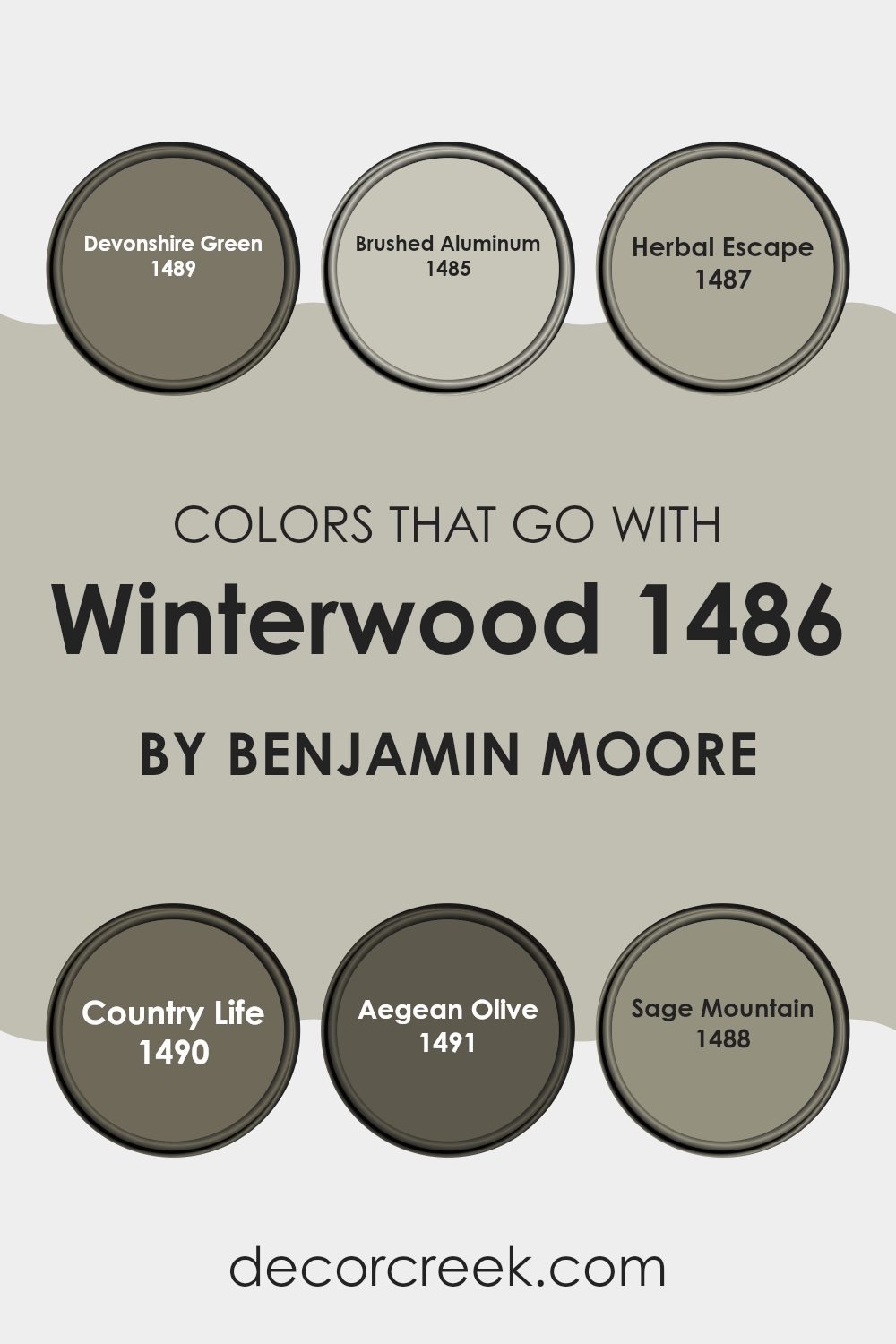
How to Use Winterwood 1486 by Benjamin Moore In Your Home?
Winterwood 1486 by Benjamin Moore is a flexible paint color that brings a cozy and warm feeling to any room. Ideal for those looking to refresh their living room, Winterwood has a subtly rich gray tone that works well in many settings, whether you are painting a bedroom or sprucing up your living room.
This shade pairs wonderfully with white trim, bringing out its unique qualities, or it can be used as an all-over color for a more unified look. In the kitchen, Winterwood can help create a welcoming atmosphere for family gatherings. In the bedroom, it offers a calm, cozy backdrop, perfect for relaxing after a long day.
It also works well in a home office, where it helps set a calm, focused environment. Accessories in bright colors or rich textures stand out against this neutral backdrop, allowing you to personalize your room effortlessly. Moreover, Winterwood helps hide everyday wear and tear on walls, making it a practical choice for busy homes.
Winterwood 1486 by Benjamin Moore vs Seattle Mist 1535 by Benjamin Moore
Winterwood and Seattle Mist, both by Benjamin Moore, offer subtle differences that could influence your choice for home painting. Winterwood has a warm, creamy tone that gives rooms a cozy, welcoming feel.
It is a soft beige with a slight grayish undertone, making it flexible for many rooms. On the other hand, Seattle Mist is a bit cooler and lighter. Ideal for creating an open, airy feel in a room, it leans more toward a silver-gray with a hint of lavender or blue.
This can make the room feel fresher and more modern. Depending on the lighting and other elements in the room, Seattle Mist might sometimes look a bit more muted compared to Winterwood’s warmer hues. Both colors can work well in most areas of your home, depending on what kind of mood and aesthetic you’re aiming for.
You can see recommended paint color below:
- 1535 Seattle Mist
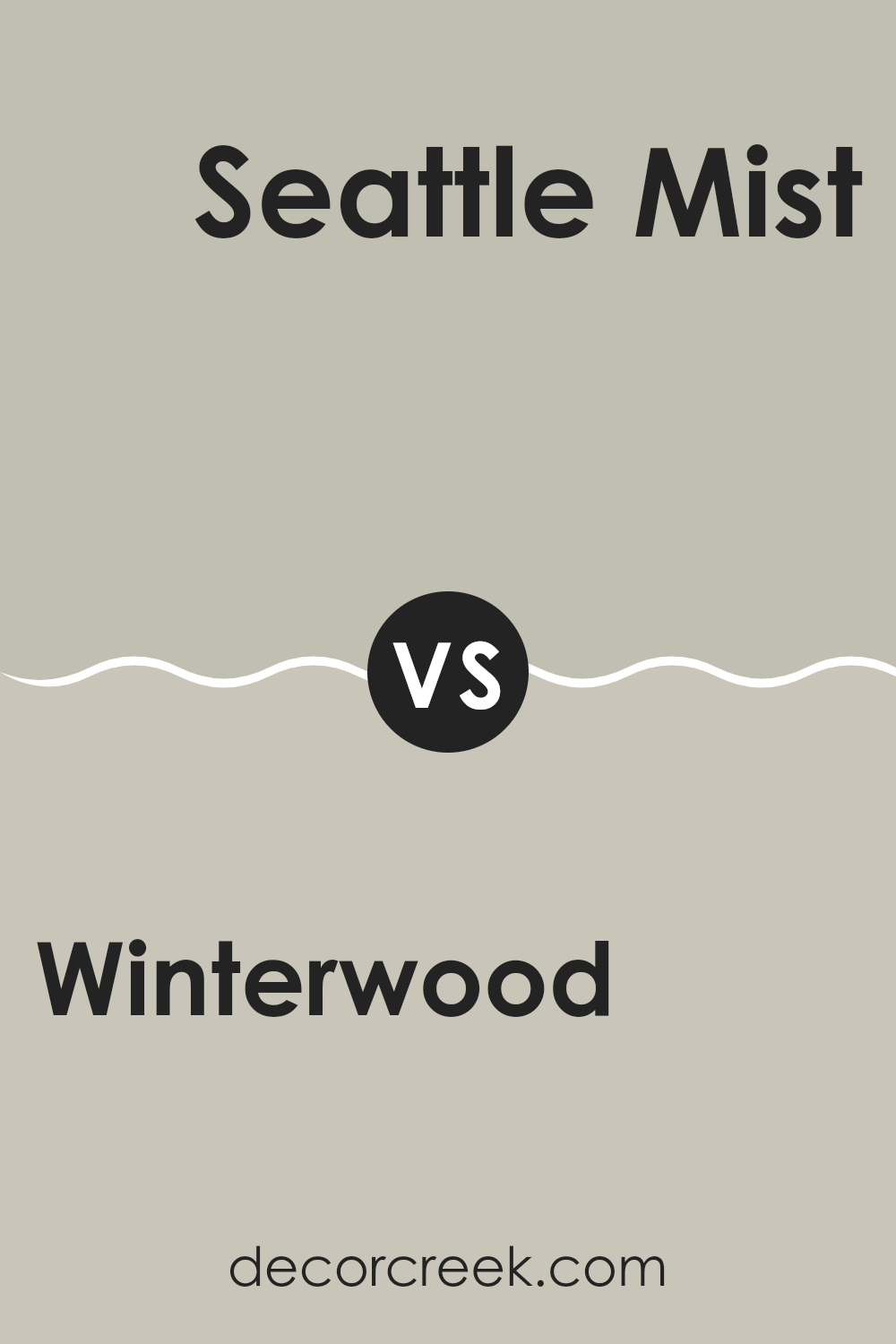
Winterwood 1486 by Benjamin Moore vs Paris Rain 1501 by Benjamin Moore
Winterwood and Paris Rain, both by Benjamin Moore, present unique shades that bring subtle elegance to any room. Winterwood offers a calm, muted green with a hint of gray, creating a cozy and restful atmosphere. It’s an excellent choice for those looking to soften a room without being too intense with color.
On the other hand, Paris Rain provides a slightly bolder gray tone that carries a hint of blue. This shade is perfect for modern rooms, giving a clean and crisp look yet maintaining a warm presence. Both colors are flexible but serve different moods and themes. Winterwood is more earthy and natural, ideal for rooms where you want to foster a feeling of comfort and relaxation.
Paris Rain, being a cooler tone, works well in rooms that benefit from a fresh, open look. When deciding between the two, consider the ambiance you want in your room: warm and inviting or cool and refined. Both shades provide a seamless backdrop for varied interior styles and furniture choices.
You can see recommended paint color below:
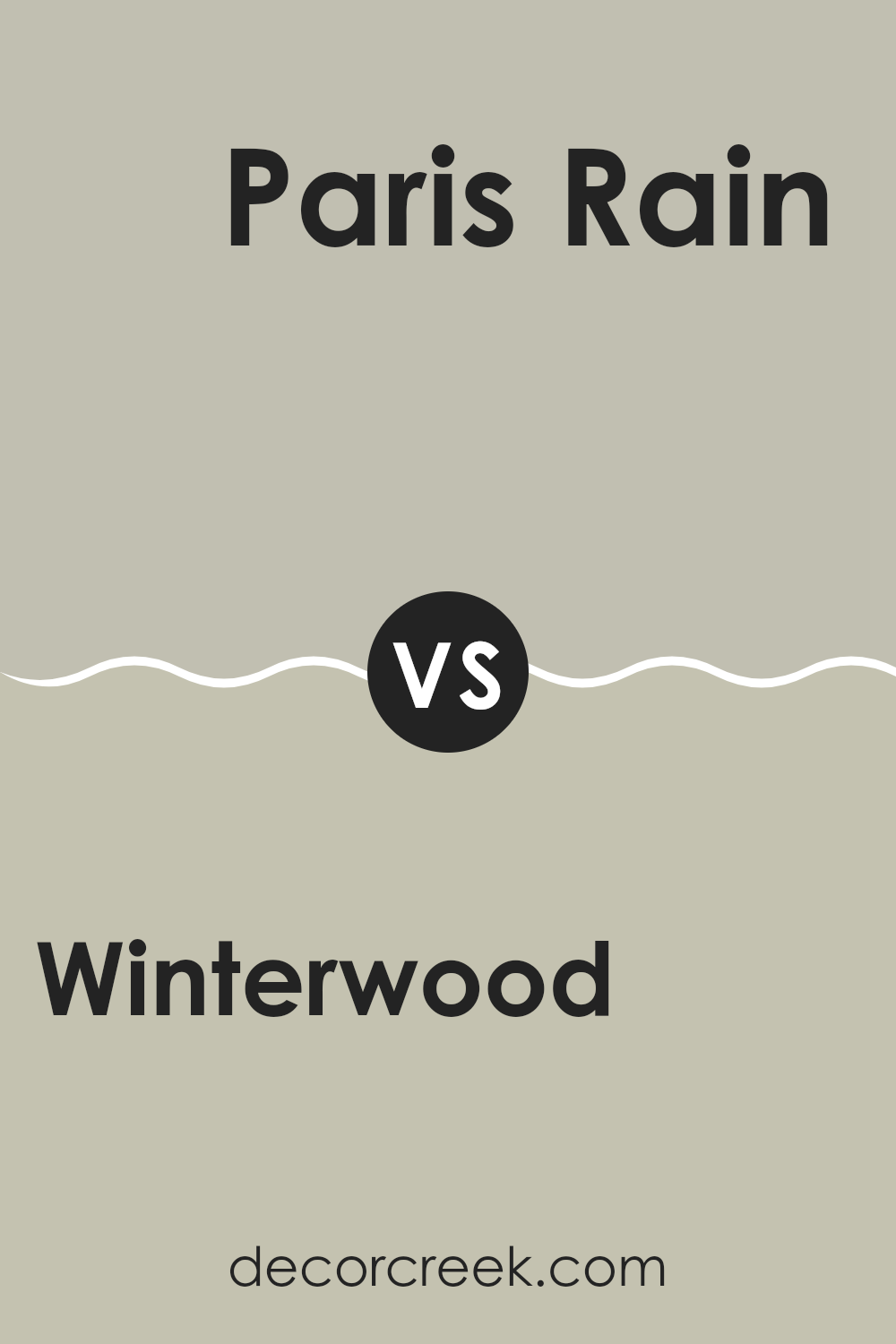
Winterwood 1486 by Benjamin Moore vs Horizon Gray 2141-50 by Benjamin Moore
Winterwood and Horizon Gray from Benjamin Moore are subtle, neutral colors that offer a calming feel, ideal for creating a relaxed atmosphere in any room. Winterwood has a gentle beige tone that carries a hint of gray, making it highly flexible for many décor styles. It’s a warm shade, which makes rooms feel cozy and inviting. It’s great for areas where you want a soft, soothing backdrop.
On the other hand, Horizon Gray is a cooler shade that leans more toward a true gray with a noticeable blue undertone. This color is lighter than Winterwood and provides a fresh, airy feel to rooms, resembling the lightness of the sky on a cloudy day. Horizon Gray works well in areas that receive plenty of natural light, enhancing an open, breezy environment.
Both these colors are understated yet distinct, offering unique vibes — Winterwood with its warm welcome and Horizon Gray with its cool freshness, making them suitable for different tastes and room functions.
You can see recommended paint color below:
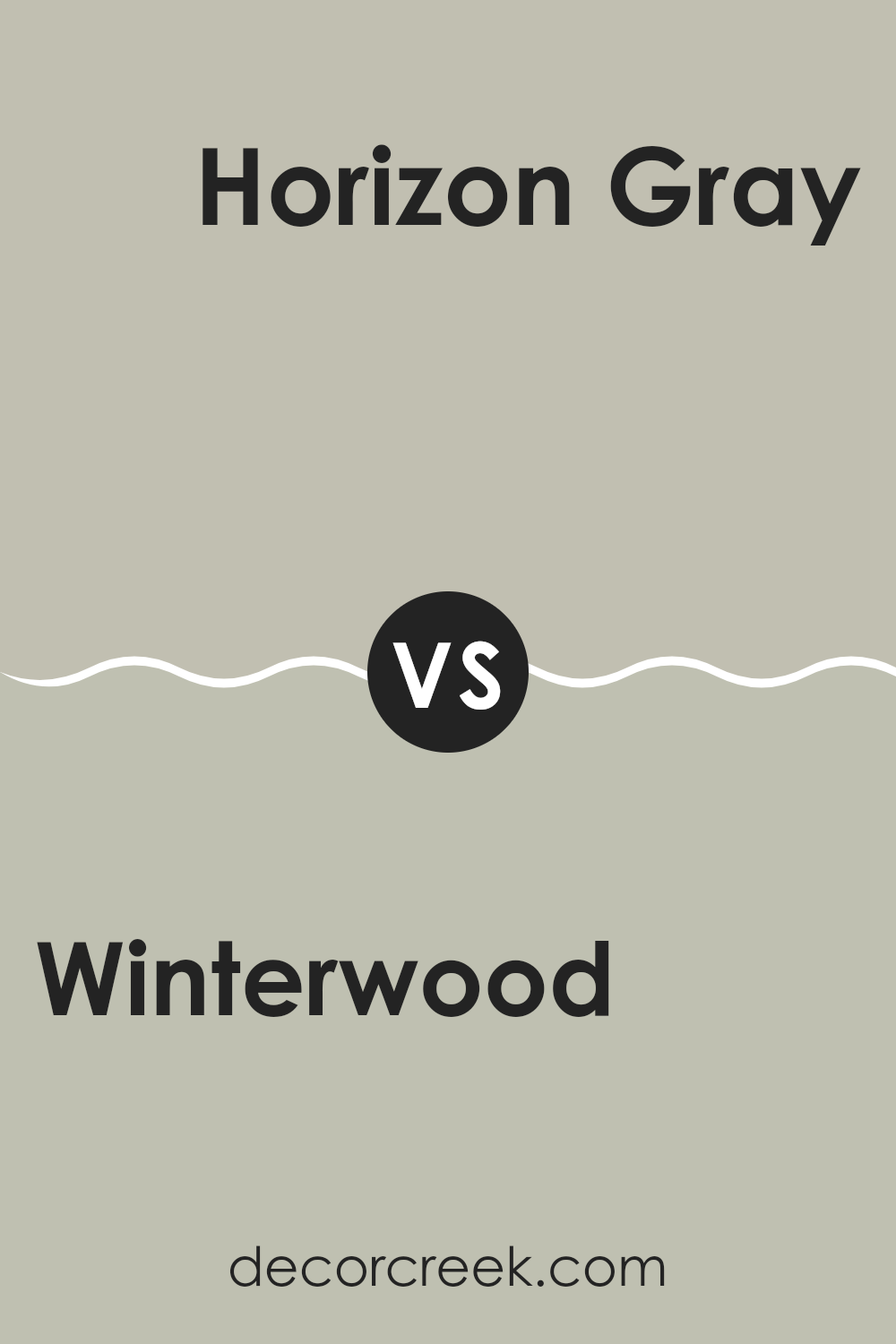
Winterwood 1486 by Benjamin Moore vs Brushed Aluminum 1485 by Benjamin Moore
Winterwood and Brushed Aluminum by Benjamin Moore are two subtly distinct shades, each adding a unique touch to interiors. Winterwood, as the name suggests, is a soft, warm gray with an understated earthiness that makes it flexible for many rooms—creating a cozy backdrop for both modern and traditional décor. Its slightly green undertones help it blend well with natural elements like wood and stone.
Brushed Aluminum, on the other hand, is a cooler tone that leans toward a light silvery-gray. This shade is crisp and can give a room a fresh, clean look. It works exceptionally well in areas that aim for a minimalist or contemporary aesthetic, offering a slight brightness without overpowering the atmosphere.
When deciding between the two, consider the ambiance you want to create. Winterwood offers warmth and works well in rooms where comfort is key, while Brushed Aluminum is perfect for achieving a sleek, fresh look.
You can see recommended paint color below:
- 1485 Brushed Aluminum
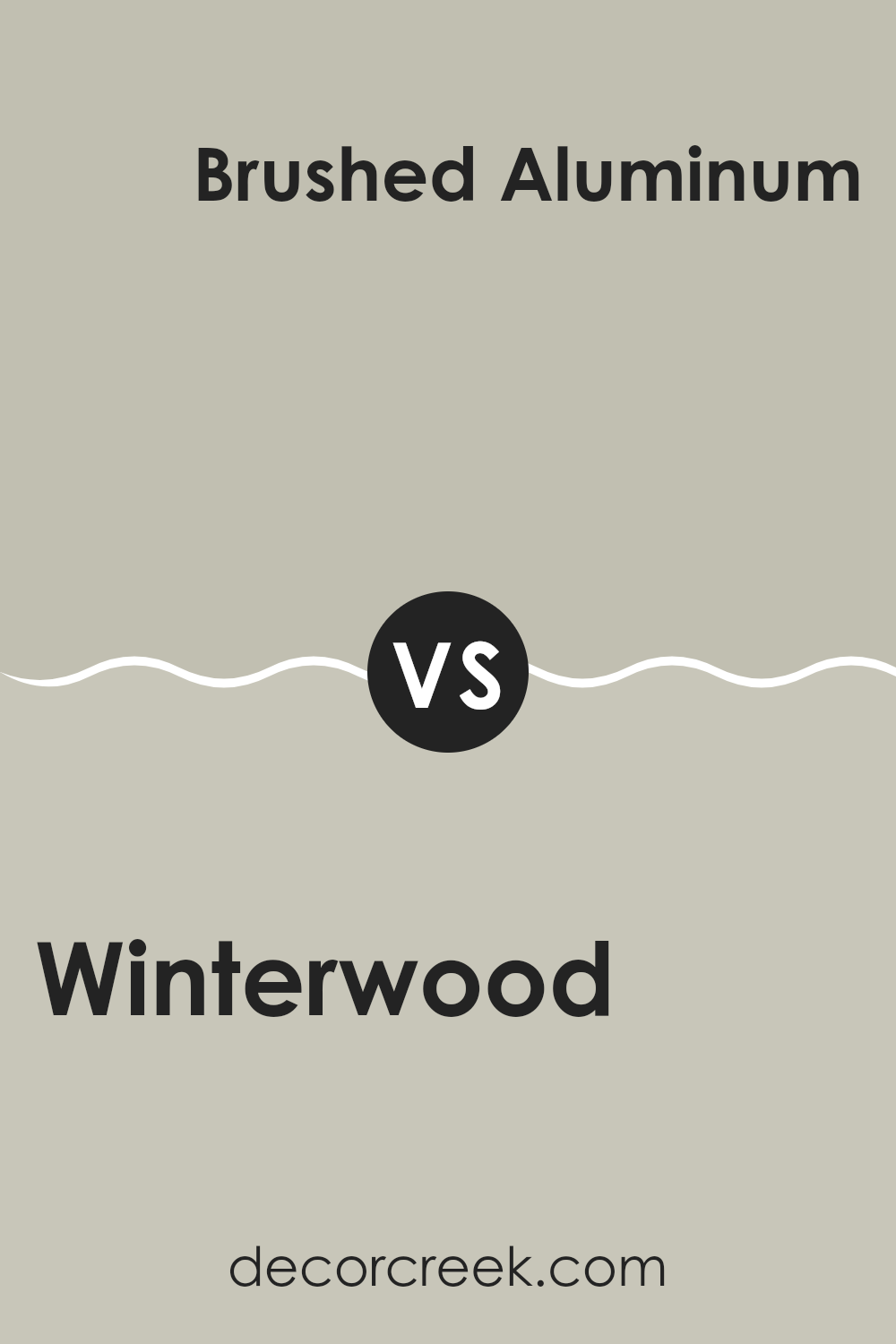
After reading about the paint color 1486 Winterwood by Benjamin Moore, I found out a lot about how this shade can make a room look great. Winterwood is a soft, grayish green color that feels very calm and gentle. It’s not too bright, but it’s not too dark either. It seems just right if you want to create a cozy corner for reading or a peaceful spot to relax in.
This shade isn’t just a simple green; it has hints of gray that give it a unique feel, making it perfect for almost any room in your house. Whether you’re painting your bedroom, living room, or even the bathroom, Winterwood could be a good choice because it’s easy on the eyes and pairs with many different things.
I found out that this shade works well with natural light, making areas look brighter and more open. When you use this paint, you can mix it with soft whites or even some darker tones for a nice contrast. From what I’ve learned, not only does Winterwood look good, but it also makes rooms feel more welcoming.
Overall, I think Winterwood by Benjamin Moore is a really nice choice if you want to add a touch of calmness and a natural look to your home without making too big of a change. It’s like a breath of fresh air for any room!
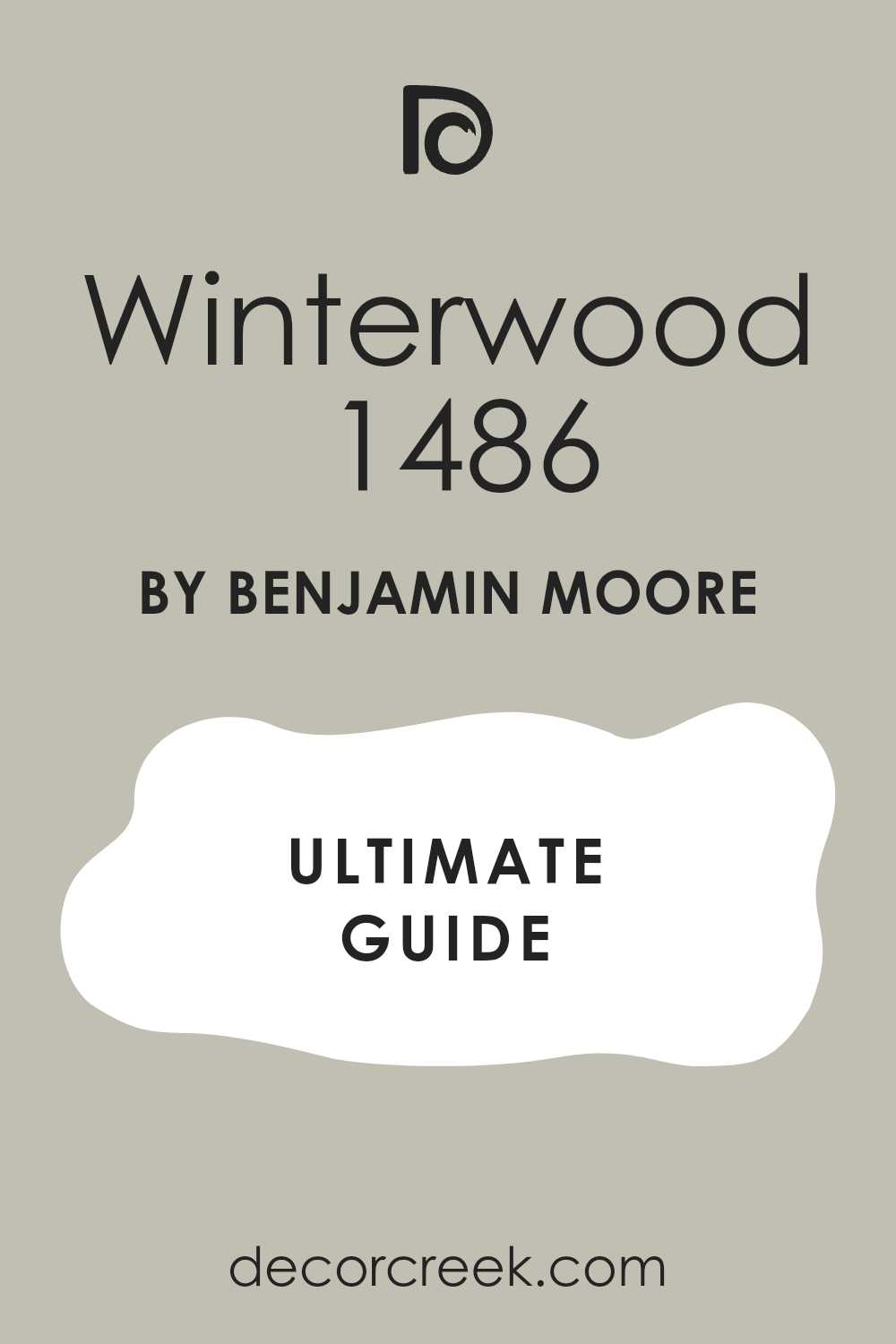
Ever wished paint sampling was as easy as sticking a sticker? Guess what? Now it is! Discover Samplize's unique Peel & Stick samples.
Get paint samples
